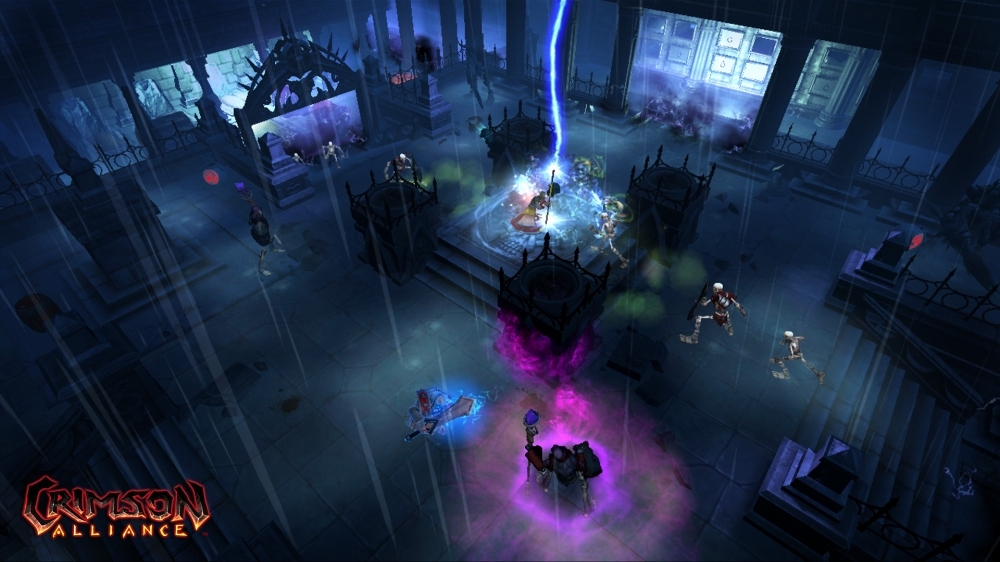You can trust VideoGamer. Our team of gaming experts spend hours testing and reviewing the latest games, to ensure you're reading the most comprehensive guide possible. Rest assured, all imagery and advice is unique and original. Check out how we test and review games here
If you’ve been able to get through the last 15 years of dungeon crawlers without being reminded of Gauntlet or its half-cousin Diablo, then I owe you a fiver. Decades after the fact, developers are still sorting out how to pull the magic out of a formula that was forged in the ’80s, which is why to the uninitiated Crimson Alliance is at risk of following the template a little too literally.
This is a dungeon crawler that doesn’t even bother with adopting the complexities of RPGs in the way that Torchlight did two years ago. The world of Crimson Alliance has no character-specific stats. Don’t go searching for skill trees either. Instead it has its own philosophy, which says something to the effect of “less fiddling, more hitting in the face.” The game holds this kind of thinking to the most holy order, and Certain Affinity’s unflinching belief in building this entirely with co-op and leaderboards in mind is – more than anything else – admirable.
The studio itself has a pedigree in multiplayer games to begin with. It was formed by ex-Bungie staff who went on to make the Tombstone and Desolation maps for Halo 2, and then collaborated with Treyarch on maps and game modes for Call of Duty: Black Ops. Crimson Alliance has more of a medieval fantasy flavour than what the studio is used to delivering, but it’s designed specifically with multiplayer sensibilities in mind.
You have three (relatively) customisable characters to choose from – a Wizard, Assassin, and Mercenary – although the game allows for four-play co-op. In fact it likes the idea of co-op so much that it will suggest, using on-screen text, when you should start thinking about pulling someone on to your other controller.
Puzzles will turn up at the centre of each level, for example, and most of them will leave you baffled without the helpful hand of a second player to stand on a pressure pad for you. It helps that combat simply looks better in co-op too.
Certain Affinity has a simple-does-it approach to hitting things. Each character is equipped with a basic and heavy attack, as well as the ability to stun, dash, and use a few consumable items as weapons. But if done right with another player, combat reveals a tactical edge. A double-team of Wizard and Merc can lay out a plan to have the former class freeze enemies, for instance, then leave the Mercenary to break those icy blocks into a hundred broken shards of crystalline death. The more variety that’s given to these kills, the more points find their way to your final score.
It’s important to point out that this isn’t a particularly loot-driven dungeon crawler. At best you might find gold scattered around a few corpses by the end of a fight, largely because the game has more arcade-like ambitions in mind. Each level ends with an overall Bronze-to-Gold score based on points made up through combat, the time it took to clear the dungeon, and the number of secret areas you were able to find on your travels. Higher combat scores are easier to maintain the higher the difficulty you play at, but generally speaking you only need to think about combining attacks and avoiding hits to increase your multiplier.
It’s interesting to note that there’s no Mana guage, which suggests just how far the studio went to making a game with as little stopping time as possible. In fact, the only move that needs to be charged at all is your Ultimate Power – essentially a special ability that you unlock by picking up certain items, and whose power charges based on how many enemies you kill.
Loot gets handled in a similar way. Instead of falling from enemies, you’ll find treasure chests inside certain hidden rooms which are marked with the symbol for your class. The weapon that drops is almost inevitably better than anything in your inventory, which essentially eliminates any ponderous min/maxing.
Which means, for better or for worse, Crimson Alliance intends to be an unabashed time-waster of a game. And yet it still manages to cultivate a pretty convincing new car smell for what’s a straight-forward Crawler. Because for all of its hack and slashisms, it’s secretly driven by ideas.
Enemies don’t just get more difficult, they get better designed. The first dungeon you wander into, an archer might wait for you to get in range before he shoots, but by the next one he’ll move to aim for the explosives you’re standing near. Similarly, slightly more advanced zombies standing on a lower level will climb up walls to get to you, rather than mindlessly waiting for you to meander down in your own time.
Other areas require you to manoeuvre around spinning, moving blades, forcing you to multitask between your combat and your footing. Others levels incorporate pressure pads that activate flames and can be used as defence against some of the weaker enemies, while foe who don’t die instantly will stumble after you aflame.
Better still is the introduction of both the gun-wielding and bomb-throwing samurai, who have an effect on just how much you need to rely on cover. Your own attacks and weapon-types will remain basically unchanged throughout the game but theirs won’t, and you will consistently need to accommodate for that.
Where Crimson Alliance could have joined the white noise of dungeon crawlers, Certain Affinity has managed to design a solid and – more impressively – distinctive game, regardless of whether the simple, pick-up-and-play approach turns off a few hardcore fans of the genre.

/https://oimg.videogamer.com/images/9953/crimson_alliance_15.jpg)
/https://oimg.videogamer.com/images/a4a6/crimson_alliance_9.jpg)
/https://oimg.videogamer.com/images/e301/crimson_alliance_4.jpg)






